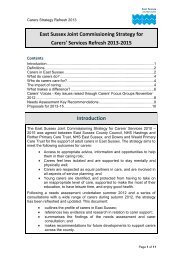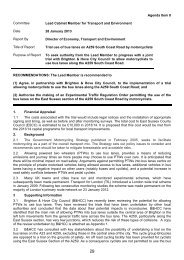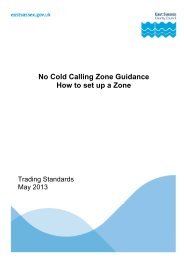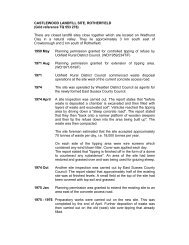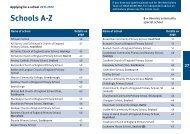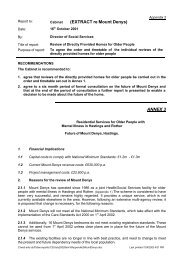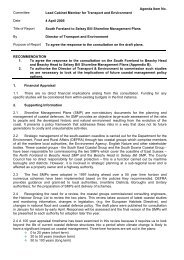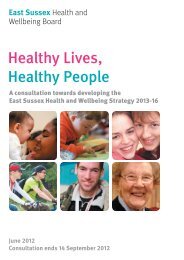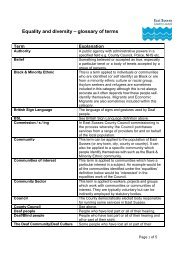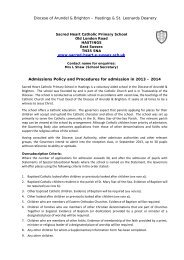Item 4 - East Sussex County Council
Item 4 - East Sussex County Council
Item 4 - East Sussex County Council
- No tags were found...
You also want an ePaper? Increase the reach of your titles
YUMPU automatically turns print PDFs into web optimized ePapers that Google loves.
Report toAgenda <strong>Item</strong>Lead Cabinet Member for Transport and EnvironmentDate 3 September 2007Report ByTitle of ReportPurpose of ReportDirector of Transport and EnvironmentIntroduction of a Quality Bus Corridor on Seaside in <strong>East</strong>bourneTo consider the results of local consultations, to consider apetition opposing the proposal, and to seek approval for theimplementation of a bus lane and cycle track along A259 Seasidein <strong>East</strong>bourne.RECOMMENDATION:To approve implementation of Option 1 comprising a 3 metres wide bus lane, andshared pedestrian and cycle surface along the A259 Seaside in <strong>East</strong>bourne, betweenGilbert Road and Whitley Road.1. Financial Appraisal1.1 A sum of £200,000 has been allocated from the 2007/08 capital programme for thisscheme. As a result of design refinements, it is now estimated that the total cost of the buslane and shared pedestrian/cycle surface, including a signalised pedestrian crossing acrossWhitley Road, will be £160,000. However, this figure may change further following detaileddesign. Ongoing maintenance will be met from general highway maintenance budgets.2. Supporting Information2.1 The improvement of bus services in <strong>East</strong>bourne is a key element of the <strong>East</strong>bourneUrban Area Local Transport Plan. It complements the introduction of decriminalised parkingenforcement (DPE), contributing to the creation of an attractive alternative to the car, whilstDPE will ensure that parking restrictions are effectively enforced, including those at busstops. The <strong>Council</strong> is party to a Quality Bus Partnership (QBP) between local authorities,bus operators and others, which aims to deliver these improvements. Under the umbrella ofthe QBP, the <strong>County</strong> <strong>Council</strong> is committed to introducing infrastructure and control measuresalong main bus corridors, to allow buses to operate more reliably and with less delay. TheSeaside corridor has been identified by the QBP as the highest priority. The bus lane atWhitley Road is one of a number of improvements along the length of Seaside, some ofwhich have already been implemented.2.2 On 25 July 2005, the Lead Member for Transport and Environment approved, inprinciple, a scheme involving a section of bus lane and cycle track between Gilbert Roadand Whitley Road. Subsequently, a safety audit identified a number of issues, and twooptions were identified to overcome them. Option 1 involved the reduction of the width of thebus lane from 4 metres to 3 metres, with the creation of a shared surface for pedestrians andcyclists on the existing footway. Option 2 involved the introduction of a 4 metres wide buslane that could be used by both buses and cyclists, but which would involve the loss ofparking on the southern side of the road. Details of these two options are set out in theAppendix to this report.3. Comments/Appraisal3.1 Statutory consultations were undertaken, and other organisations and occupiers of910 properties in the surrounding area were invited to comment. The results of the
APPENDIX 1Seaside Quality Bus Corridor – Phase 1Proposed Bus Lane & Cycle Track between Gilbert Road & Whitley Road, SeasideReport on ConsultationLetters setting out the details of the modified proposals for the Seaside bus lane and cycletrack were sent to the occupiers of the properties that were likely to be directly affected bythe revised proposals. These letters were sent to properties in area bounded by AnningtonRoad, Clarence Road, Beltring Road, Ringwood Road, Eshton Road, Latimer Road andHanover Road.In addition <strong>East</strong>bourne Borough <strong>Council</strong> and the statutory consultees were consultedabout the two options. The statutory consultees include the emergency services, busoperators, Freight Transport and Road Haulage Associations, <strong>East</strong>bourne HighwaysManager, <strong>East</strong> <strong>Sussex</strong> <strong>County</strong> <strong>Council</strong> Passenger Transport Group, AA Route DataResearch, RAC Motoring Services and the <strong>East</strong>bourne & District Chamber of Commerce.The modified Seaside bus lane and cycle track proposals were sent to a total of 910 localresidential, business and organisations on the 2 July 2007. The closing date for responseswas 20 July 2007.A total of 141 response forms were returned, representing a response rate ofapproximately 15%. The response form asked respondents to indicate which bus lane andcycle track option they preferred and included a comments box where respondents couldnote their views about the proposals. The results of the consultation are shown in Table 1below.Table 1 – Consultation ResultsOptionsNumber ofResponsesPercentageOption 1 - A 3 metres wide bus only lane, withshared cycle/footway on the pavement 40 28%Option 2 - A 4 metres wide shared bus andcycle lane, involving the loss of parking on theopposite side of the road12 9%Neither Option 1 nor Option 2 84 60%No preference/ Don’t Know 5 3%Total 141 100%1
Response from Statutory Consultees and Other Organisations<strong>Sussex</strong> Police“Option 2 would incur loss of parking on street outside a number of properties in Seaside.This would seem to be difficult to reconcile as it is to accommodate use of the bus lane bycyclists for which in your own notes you state “the level of cycling along Seaside is low”.Option 1 achieves the initial objective of providing a cycle lane and dedicated bus lane withless adverse effects on nearby residents.”<strong>East</strong>bourne Buses“Whilst the narrower bus lane may seem a strange choice for us, the small number ofcyclists should be able to mix safely with the pedestrians. This also means that some localresidents may be able to retain a limited level of parking.”<strong>East</strong> <strong>Sussex</strong> Fire and Rescue“Option 2 would bring in parking restrictions on the South Side of Seaside. This wouldprovide the better access for emergency vehicles, of the 2 Options available.”<strong>East</strong>bourne Borough <strong>Council</strong>A report about the bus lane proposals was presented to the <strong>East</strong>bourne Cabinet on 23July 2007. At this meeting the Cabinet resolved that the response agreed by the Leader ofthe <strong>Council</strong> and sent to the <strong>County</strong> <strong>Council</strong> on the 13 July 2007 be endorsed:“The <strong>East</strong>bourne Cabinet do not believe that the introduction of a bus lane at this point isnecessary and support the concerns of local residents in the area that such introduction islikely to lead to the introduction of rat-run in local neighbourhood roads (including thosecrossed frequently by young children to access the Seaside Recreation Ground). TheCabinet would urge <strong>County</strong> to abandon these plans and instead concentrate their effortson resolving the considerable problems of traffic management which exist at the Tesco’sroundabout, which regularly cause long delays to all highway users, including buses.”Analysis of CommentsAn analysis of the comments is presented in Table 2.2
Beamsley Road and Barden Road, meaning thatthe existing pavement width outside the propertiesalong this section of Seaside would be retained.It is recommended that the existing signalisedpedestrian crossing on Seaside be movedcloser to the junction of Beamsley Road andWhitley Road, as part of the bus lane proposals.CyclingCyclists should not use the pavement. It isdangerous for pedestrians and not enforced byPolice.Combined Bus Lane/Cycle path preferred ascyclists already use the pavement with disregard forpedestrians.Use of cycles in Seaside is low. There is no needfor the cycle path and it is too shortMixing bikes and buses in the same lane isdangerous. Cyclists are safer separated fromtraffic.92117The scheme proposals have to take account of allhighway users including cyclists and thereforeprovision has to be made for them to safely travelthrough the junction. Both options would providesafe facilities for cyclists, however, only theproposed bus lane in Option 2 would be wideenough to enable cyclists to safely use the buslane. Option 1 proposes that cyclists share thefootway with pedestrians. As the level of cyclingalong Seaside is low, it would be permissible forcyclists share the footway with pedestrians inaccordance with government guidelines.It is recommended that cycling facilities beimplemented as part of the bus lane proposalsunder either option 1 or 2.Need safe dedicated cycle routes all over town (likeCambridge); small unlinked schemes will be awaste of money.6Seafront schemes should be targeted e.g. reinstatecycle path by the Redoubt and round the bowlingclub on the seafront34
RelocatedBus StopMoving bus stop is a very good idea 2Remove bus stop altogether so buses are not heldup by stopping at bus stop. It is not heavily used.4Bus laneCongestionMoving bus stop outside pub is not a good idea -people waiting would cause a nuisance to residentsin the new location.Would need longer bus lanes into and out of town,along the whole length of Seaside to improve busservice.Bus lane not needed, as congestion is on theapproach to Seaside (Tesco) Roundabout from theArchery area. This is where problems should besolved.Seaside is busy for large parts of the day. The buslane would increase congestion and frustrationamongst motorists.52747 It is recognised that there are congestion problemsin this area, however they cannot be tackled inisolation and traffic flows over a wider area,including the surrounding junctions need to beconsidered. The <strong>County</strong> <strong>Council</strong> has approvedfunding for a study to look at possible solutions tothese problems in 2007/08.12 The Real Time Information system recentlyintroduced in <strong>East</strong>bourne allows buses to betracked as they move around town. It also allowstraffic signals to be changed to green for a bus onits approach to signal controlled junctions orpedestrian crossings. This system, combined withthe bus lane and associated bus gate (separatetraffic lights for the buses) would allow buses tobypass congestion at the Whitley Road junction. Inaddition, it could be possible to detect buses on thewestbound (in to town) approach to the junction,allowing the buses to trigger a green signal thatcould benefit the buses and some general traffic
(immediately in front or behind the bus) in thestraight ahead lane. Using the Real TimeInformation system to give buses priority atsignalised junctions and pedestrian crossings wouldhelp to improve the reliability of bus services alongSeaside.Bus buildouts along Seaside cause congestion andshould be removedNumber of pedestrians crossings between Archeryand Seaside roundabout contributes to congestion11 These were installed to prevent vehicles parking atthe bus stops and so that passengers, especiallythe elderly and parents with buggies, would nothave to squeeze between parked vehicles to boardbuses. The proposed <strong>East</strong>bourne Parking schemewould allow a higher level of enforcement in thetown and at bus stops. The provision of busbuildouts could be reviewed in light of the improvedparking enforcement and consideration would begiven to their removal.4 The new signalised pedestrian crossings calledPuffin crossings also make use of technology toreduce delays to traffic. The crossings have sensorswhich detect when pedestrians are crossing theroad or waiting to cross the road. The sensors canextend or reduce the amount of time pedestriansneed to cross the road, so if pedestrians cross theroad quickly, the Puffin crossing sensors detectsthis and changes the lights to green to traffic assoon as it is safe do so. The sensors can alsodetect when pedestrians have decided not to crossthe road or have crossed before the lights havechanged and can cancel the pedestrian crossingdemand. This avoids traffic being stoppedneedlessly.6
ParkingOne-wayRoadsSpeedTableParking in the area is already a big problem andcould get worse if the bus lane implemented.Loss of parking spaces on Seaside wouldinconvenience local residents and could be unsafeat night, if people have further to walk.Probably case for making Addingham Road onewayIf Barden & Addingham Roads made one-wayRedoubt Road may become busier and it isopposite the proposed relocated bus stop & shelter.Speed tables required at various locations includingAvondale Road end of Gilbert Road, Leslie StreeThe pedestrian crossings along Seaside also havea central island, which means pedestrians cross theroad in two halves. This can mean pedestrians cancross in gaps in the traffic flow or could stop trafficin one direction at a time. In both instances thiswould reduce delays to traffic along Seaside.9 There are already no waiting restrictions preventingparking along Seaside between Beamsley Roadand Barden Road and both options would notchange this situation. However, under Option 1 theexisting parking along Seaside between BardenRoad and Redoubt Road would be retained. Thiswould involve some minor carriageway wideningalong Seaside between Barden Road andAddingham Road, to maintain safe traffic flow,although a 2 metre wide footpath would be retained.9213Speed table in Gilbert Road not needed 3Rat Running Speed table will not stop vehicles speeding up 2 The bus lane would reallocate road space in favour7
Gilbert Roadof buses and it likely that this will increase thelength of queues for general traffic along Seasideon the eastbound approach to the Whitley Roadjunction. Rat running on the roads adjacent toSeaside is already an issue. Should it be decided toimplement the bus lane, traffic counts would beundertaken in neighbouring roads before and afterits introduction. If it were found that there has beena significant increase in the number of vehiclesusing the neighbouring roads, then considerationwould be given to the introduction of traffic calmingmeasures.It is recommended that the rat running situationin the neighbouring roads is monitored andconsideration be given to future traffic calmingmeasures.TrafficLightsThe bus lane will result in even more cars usingother local roads such as - Gilbert Rd, Avondale Rd,Leslie Street, St Philips Avenue, Ringwood Road,Beltring Road, Addingham Road, Latimer Road andFirle RdBuses unlikely to gain much time at Whitley Roadtraffic lights and any time gained will be lost furtheralong Seaside towards Seaside Rounabout.Proposed new traffic lights at the WhitleyRoad/Seaside junction will cause confusion andadditional delays.9125 As part of the bus lane proposals it is intended toupgrade the Whitley Road traffic signals andintroduce a new traffic lights control system. Thiswill use modern technology to control the trafficlights more efficiently by responding to trafficdemands on each arm to reduce delays. This would8
help to reduce queues and keep pollution at thejunction to a minimum.PollutionConcerned about pollution from exhaust fumes 6Scheme will bring traffic and pollution nearer theirhomes.2TreesReplacement trees required to replace two treesbeing removed within the areaDo not want to loose two mature trees for bus lane 164In order to maintain the existing pavement widthoutside the properties between Beamsley Road andBarden Road, it would be necessary to widen thecarriageway outside the Seaside RecreationGround, resulting in the loss of two trees. Themature trees would be replaced in line with the 2 for1 replacement policy for trees in <strong>East</strong>bourne. The<strong>County</strong> <strong>Council</strong> would work with the <strong>East</strong>bourneBorough <strong>Council</strong> Arboriculturalist to plant thereplacement trees as close as possible to thoseremoved.It is recommended that replacement trees areplanted as close as possible to the treesremoved as part of the bus lane proposals.BollardsOption 2 Bollards opposite relocated bus stopwould be dangerous for pedestrians, as vehiclesmight squeeze between the bus at the stop and thebollards1GeneralOption 1 achieves your aim with the least amount ofdisruptionOption 1 would be best – but would prefer neither/do nothing27There is considerable variation in the journey timesin both directions along Seaside in the AM and PMpeak periods. For example, the average eastboundjourney time along Seaside between the towncentre and St Anthony’s Avenue in the PM peak9
Neither option will improve the bus service to anygreat degree.Scheme is waste of money 42Spend money on better maintenance of pavementsand roads145(17.00 to 18.00) was 6 and a half minutes but thelongest recorded time was 8 and three quarterminutes. The variability in the journey time alongSeaside has a detrimental impact on the reliabilityof bus services. One of the main objectives of thebus priority measures on Seaside is to improve thereliability of bus journey times. The findings ofresearch on bus priority undertaken for theDepartment for Transport indicate that extensivebus priority measures can reduce the variability oftravel time for buses by up to 16 percent.”10



